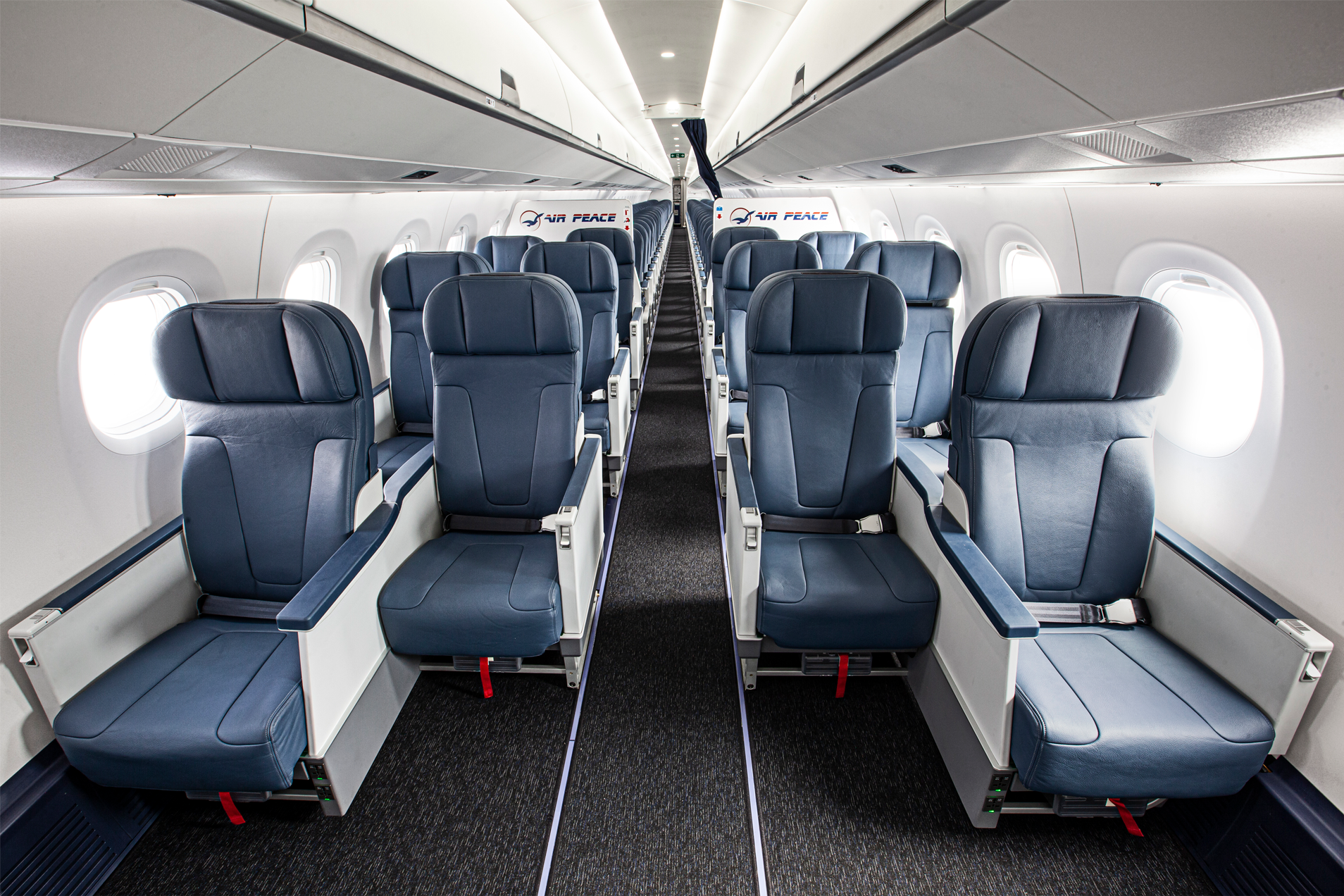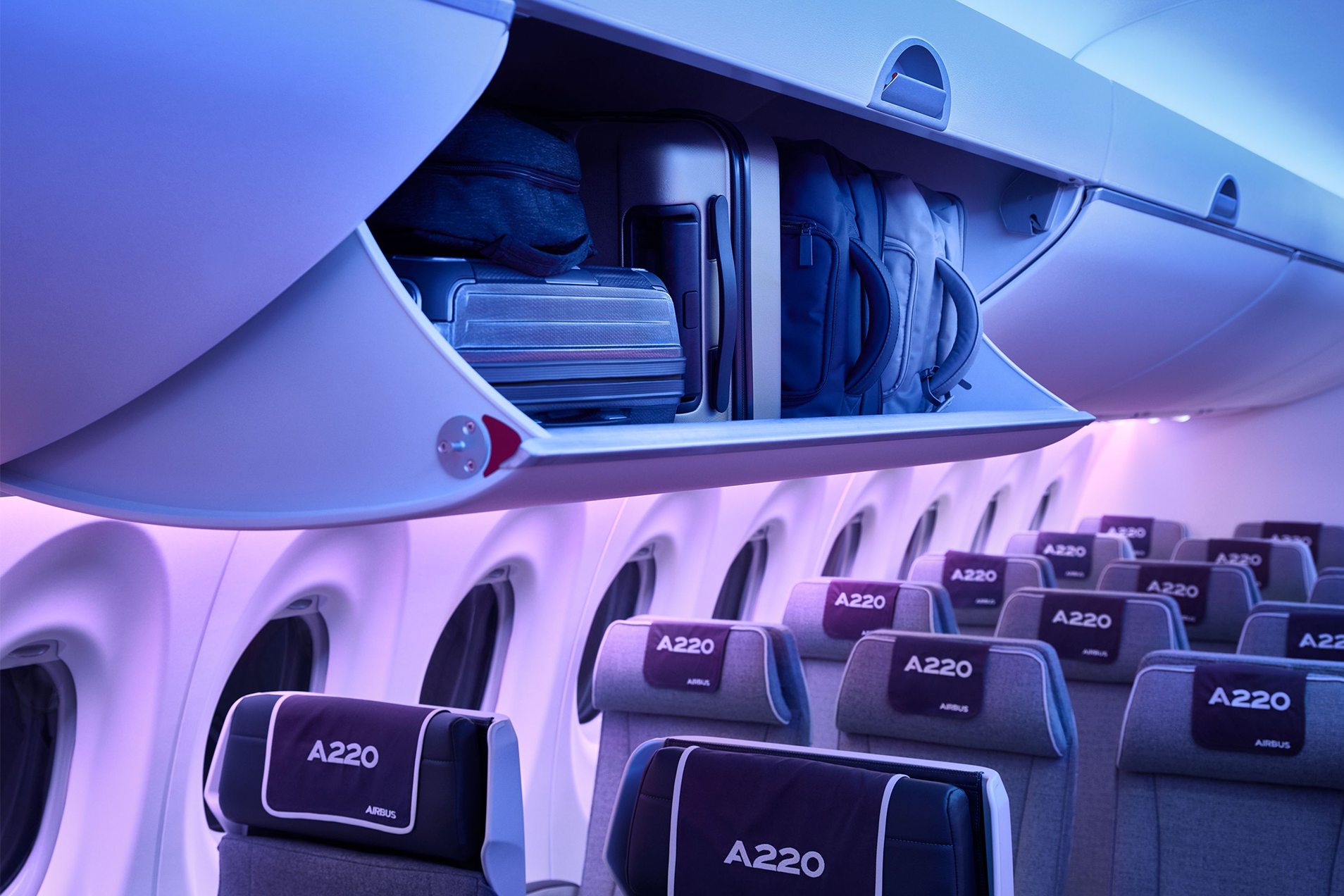
Delivering comfort in what was once thought of as a niche segment, crossover narrowbody jets such as the Airbus A220 family and the first and second generations of Embraer E-Jet families have changed the way in which airlines address capacity requirements between 90 and 150 seats. And it is in the interiors of these types that much of the progress has been made.
When the E-Jets E2 and A220 (originally the Bombardier CSeries) families were designed, the OEMs behind them promised bigger overhead bins, larger windows, bigger toilets with better accessibility, better galleys and much more noise suppression, compared with previous types in this sector.
According to Embraer’s strategic marketing director, Daniel Galhardo, one of the major innovation drivers behind the E-Jets E2 cabin concept was the improvement of passenger comfort by enhancing personal territory. “The focus on the passenger experience, comfort, space, and safety, was at the center of the E2 program from the beginning. Not having a middle seat, of course, remains a key differentiator for Embraer,” he emphasizes.
“Respect for the individual and their comfort was designed into the E2. For example, it is the only family of aircraft that offers individual PSUs (passenger service units). This gives each passenger individual control of their immediate environment, through light and ventilation, that not only provides a significant improvement in the passenger’s sense of wellbeing but also avoids the need to touch common areas.”
Air Peace is a new E195-E2 operator, the Nigerian airline actually being the launch operator for the E2 model in Africa. Importantly, the carrier is also the first to configure a premium cabin with Embraer’s staggered seat option. “Each of the 12 business class seats is slightly offset from the other to give more space and privacy. There are three rows of seats arranged two-by-two at 51-inch pitch,” the OEM notes. “Passengers by the windows have unobstructed access to the aisle; they don’t need to awkwardly step over their seat mates or ask them to move.”
“In the new environment some advances are amplified – for example, faster less hassle boarding and deplaning, made possible by the massive increase in luggage space,” Galhardo continues. “This really helps manage distancing as airlines adopt row by row deplaning during the COVID crisis. In fact, due to the pandemic, some of the improvements from the passenger point of view, became even more relevant as increased personal space moved from the status of simply ‘nice-to-have’ to being considered ‘essential’.”
Ingo Wuggetzer, vice-president of cabin marketing at Airbus, notes that the A220 comes from a ‘clean sheet’ design aimed at providing “leading cabin comfort, ambiance and service in its class”, with key features including: the largest windows, widest seats and largest bin volume in class; full LED lighting; OLED passenger service unit PSU displays; and a lavatory with PRM accessibility.
The VP highlights that the extra space in the A220 larger overhead bins allow each passenger to stow a roller-bag. “This provides a stress-free environment to both passengers and the crew, as well as decreasing turnaround time,” he remarks.
“Comfort, however, is not only about spaciousness. Airbus designs its aircraft interiors to improve the wellbeing of people flying on board by providing a quiet environment inside the cabin and using natural and ambient lighting for a more relaxing flight experience,” Wuggetzer adds.
One of the A220’s major customers, JetBlue Airways, recently took delivery of its first from an order for 70 and showed off its designs for the interior, the reviews of which have been positive.
The airline states that each of its A220 “is outfitted with the Collins Meridian seat, customized around customer feedback and featuring a number of design elements with comfort and convenience in mind”. The 3 + 2 configuration is a first for the airline, which it hails as offering “multiple seating options for all party sizes”.
Spaciousness is amplified for those paying a premium with six rows of “Even More Space” seating, while enhanced cushion comfort and adjustable headrests is offered throughout with premium Ultraleather. This softer, more breathable fabric is vegan, enabling the carrier to underline its ‘green’ credentials.
Nathan Kwok, vice-president of marketing for the A220’s interior provider, Safran Cabin, picks up on the theme of a relaxing flight experience. “The aircraft was designed to bring a widebody feel to the narrowbody segment. A lot of that spacious feeling comes from the large 11 inch x 16-inch windows, which are more than 50% larger than anything else in the single-aisle market,” he comments. “It was also the first single-aisle aircraft designed around larger pivoting overhead bins, with the A220-100 holding a class-leading 90 roller bags.

“Also, most single-aisle aircraft have moved to narrow aft lavatories in the 30”-34” range, while the A220 features a full-sized 36” lavatory standard. The optional wheel-chair accessible model is even more spacious, and features a floating sink design and expanding entry door to improve accessibility,” Kwok states.
Already touched upon is the way in which the COVID pandemic has challenged the industry. “When the COVID pandemic struck, it brought with it many operational challenges, and it also forced us to re-examine the entire travel paradigm,” the Safran VP recalls. “Single-aisle aircraft are now envisioned for routes much longer than in the past, and the once rigid lines between economy and business class are now blurred. Most of all, cabin hygiene is now at the forefront of our R&D efforts in our Travel Safe program.”
Crossover narrowbody types have some of the latest advances in this area. For Airbus, a comfortable and healthy passenger and crew environment “has always been the top design requirement for Airbus and is therefore of course part of the ‘Clean Space’ – one of the key Airspace ‘DNA’ pillars”, according to Wuggetzer.
“The air in Airbus aircraft cabins is a mix of 50% fresh air – drawn from outside – and 50% recirculated air that goes through the HEPA (High-Efficiency-Particulate Arrestor) filters, which remove particles in the air down to the size of microscopic bacteria and virus clusters with an efficiency of over 99.9%. These filters provide air that meets the standards set for hospital operating theatres,” Wuggetzer adds. “HEPA filters are only one of the components that make the cabin environment safer than other indoor environments. The high rate of cabin air renewal – every two to three minutes compared with every 20 minutes in offices – and the top to bottom airflow that limits the spread between seat rows, also contribute to the very low risk of virus transmission on board an aircraft.”
Also helping to keep COVID transmission low will be the use of antimicrobial surfaces in other touchpoints of the cabin to provide a more hygienic travel experience. Kwok says that Safran is We are developing a suite of touchless lavatory amenities, and has entered into a co-development partnership with 3M to develop hygienic surfaces. “3M is drawing on its extensive experience providing antimicrobial products to hospitals, and we are combining that with our certification expertise to bring these technologies into the cabin,” he confirms. “This includes developing coatings, films, and embedded polymers that make surfaces anti-microbial, easier to clean, and resistant to UV light.”
Galhardo reports that Embraer is likely to use some of these technologies for the E2’s lavatories. “We are evaluating a sterile lavatory offering, bringing together measures such as UV-C disinfection of surfaces every time a passenger exits the lavatory, anti-microbial materials and further touchless technology in areas such as the toilet lid, waste flap, the soap dispenser and the door latch,” he says.
As many elements originally designed to provide an advantage for airline customers are now considered essential and mandatory, new differentiators will define the evolution of crossover narrowbody jet cabin interiors. Given that these types are now a crucial segment of the airline market, it surely will not be long before some of those new ideas are unveiled.






Comments